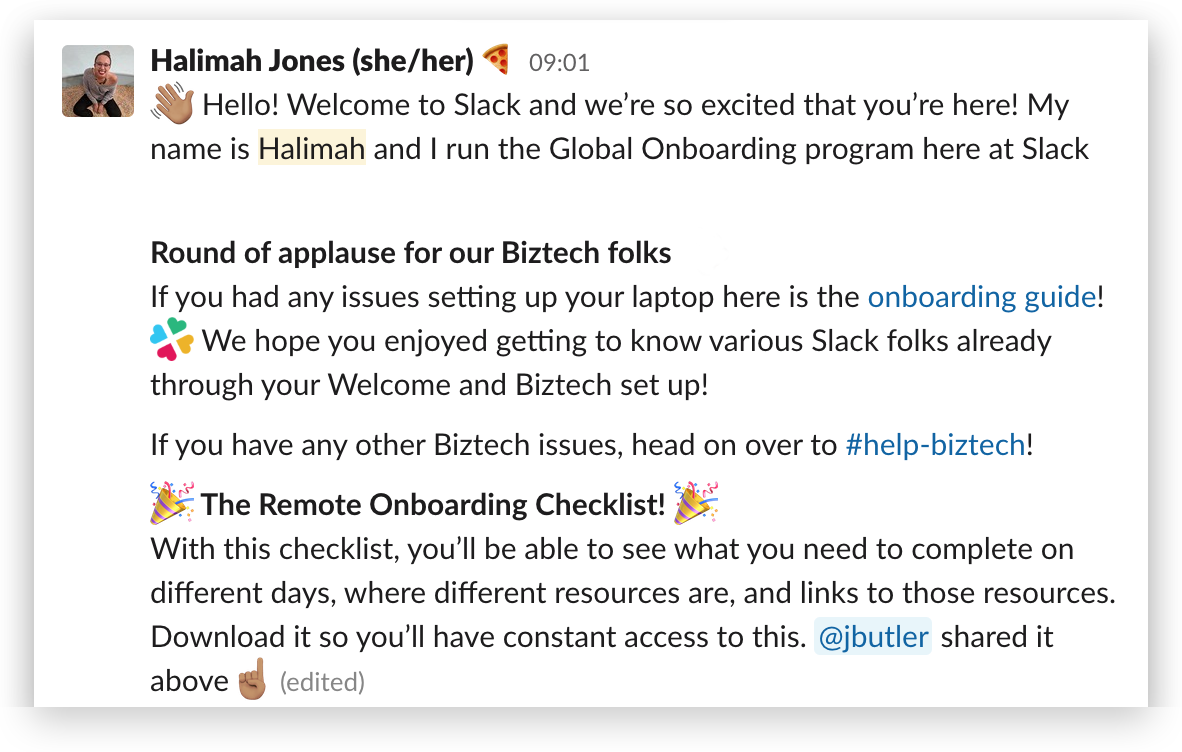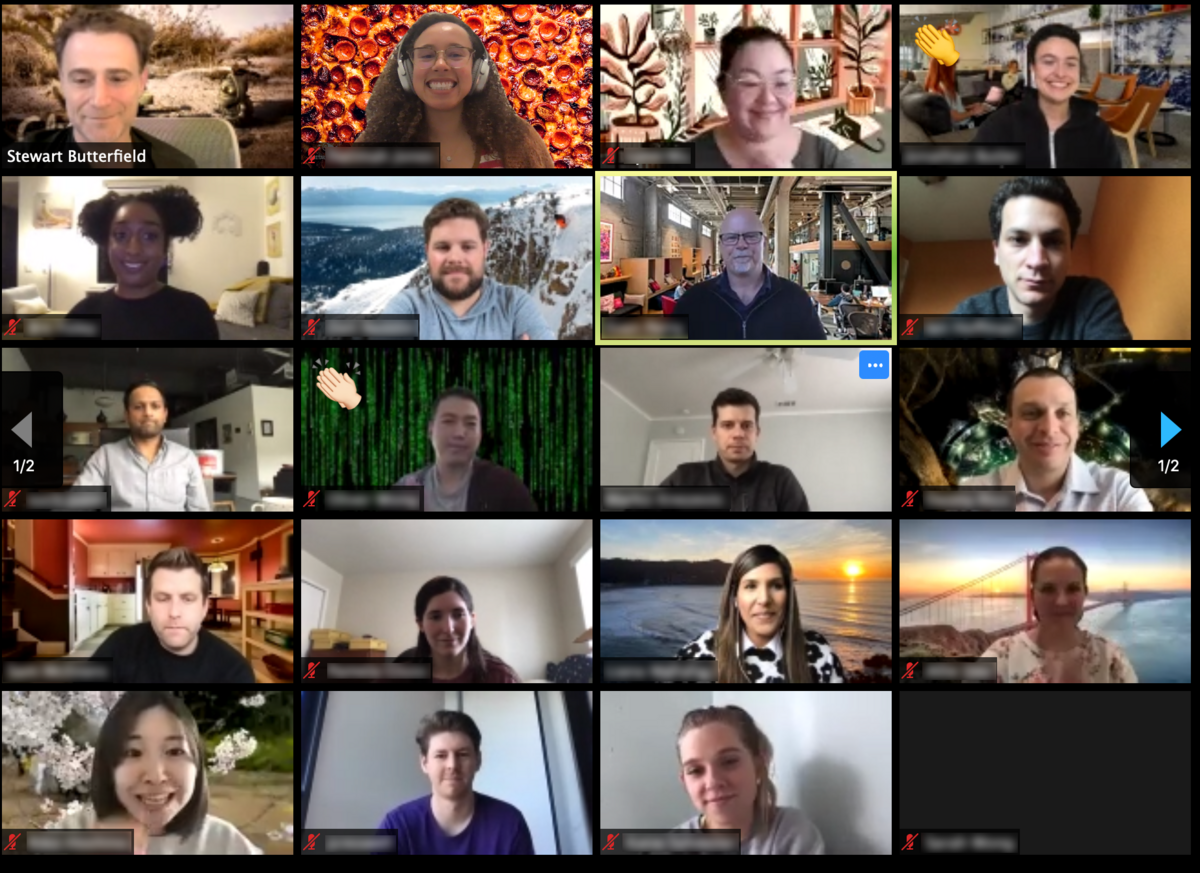Slack has 16 global offices, and no matter which of them new employees called home, they’d spend their first week in San Francisco, along with their fellow new hires. These full-day, interactive onboarding sessions included how we use Slack at Slack, company culture, the usual security and legal policies and, to cap it off, a 90-minute, in-person Q&A with CEO Stewart Butterfield.
Rethinking methods in the midst of change
As March 2020 began, well before most lockdown orders were issued, it was clear that our onboarding methods weren’t sustainable in a developing pandemic. For Slack’s Organizational Effectiveness (OE) team, the idea to someday move our onboarding to a mostly online or remote model, along with the help of local offices, needed to happen immediately.
The first task? Identify leaders from every office and train them to deliver onboarding locally, so that no new hires would have to risk travel to San Francisco. Office managers, who already welcomed folks on their first day in their local office, were a natural fit and able to jump in.

These local leaders were added to channels where the OE team quickly got them up to speed. “This was something we were only able to achieve with Slack,” says Halimah Jones, an OE partner who leads Slack’s new-hire onboarding program. “Everyone could see all the information shared in the channel and get caught up on the conversation and available resources.”
Keep the essentials, and cut where you can
Before the team could create any remote-first onboarding content, they had to edit the existing material aggressively. Our previous onboarding consisted of more than 20 hours of in-class time, featuring an instructor and various guest speakers, where Jones got to know every new employee personally in the process. But a new version couldn’t just be converted to 20 hours of Zoom video.

The OE team went through onboarding content session by session and kept only what was absolutely vital. Laptop setup for each new hire still had to take place on day one, but instructions were delivered over Zoom with help from our Business Technology team. A few of our popular guest speakers had previously recorded their sessions for weeks when they couldn’t attend in person, so those could quickly fill in for live instruction. Q&As were then conducted in Slack channels, with Jones answering as needed.
Sessions that typically didn’t have much Q&A, such as our security and legal compliance seminars, were replaced with recordings that each new hire could watch on demand.

To help keep track of everyone’s progress, the OE team created a five-day checklist for new hires. Employees would not only know what to expect each day but could also see what tasks they’d need to complete at any point in the process.
In the end, those 20 hours of in-person instruction were cut down to about three hours of Zoom sessions. These focus on Slack’s culture—specifically feedback and collaboration, and how our culture is ingrained into how we use Slack at Slack. These interactive sessions instill a sense of togetherness and belonging within the new-hire cohort. Our OE team considers this paramount, which is why we continued to facilitate these sessions digitally for our new hires. Session recordings were available to those who were unable to attend.
At the end of each week, leaders from each office and OE gathered in a #replanning-covid-2020-onboarding channel to discuss what worked and what didn’t, and how they could iterate on the experience accordingly. After about a month of experimentation, we’ve settled into a fairly stable new version of remote-first onboarding.
Things we’ll stick with even when we (eventually) return to offices

Any period of rapid change should be followed by self-reflection. After a month of quickly retooling and another month of settling into the new normal, the OE team has noticed that several things are working quite well and will likely stick around long-term.
- The onboarding checklist has become a hit with new hires, managers and OE staff. Steps that were previously implied are now explicit. The checklist helps remind everyone to fill out their paperwork and do all those tedious first-week tasks at just the right time.
- Our local onboarding office leads are a new asset we’ll stick with long-term. They’re in private channels with the OE team and deliver critical new-hire feedback to help everyone continue to improve on the process.
- Sessions with our liveliest guest speakers are still a big hit, and might return as scheduled live instruction over Zoom instead of recordings.
- Sessions on security and privacy compliance, which are typically less interactive, will likely be retained as videos for self-directed learning.
- Instead of a centralized operation based in San Francisco, our onboarding is now more of a hub-and-spoke model. Each office is empowered to formalize local support of new employees.
How to replicate this at your own company
The past couple months have required a great deal of agility and change for organizations of every size, but we wanted to compile a list of lessons we’ve learned over the years that you may want to adopt in your own company’s push to remote onboarding.
- We create a special Slack workspace, separate from the company workspace, for new hires. Here, our recruiters and OE team can answer questions and send reminders to new hires ahead of their first week. New employees can also interact with one another, get to know their cohort, and test out their new powers in Slack, without pressure. Doing everything in Slack also means no more work emails at all, which gets them used to not using email at their new job.
- Record any live Zoom onboarding sessions you conduct over the week and repost them in your Slack channels set aside for new hires. Employees who weren’t able to attend can catch up when convenient, and anyone in the group can easily reference the material later.
- Gather feedback from surveys sent in Slack using Qualtrics. Survey results can post to private channels, where your onboarding team can review and incorporate the feedback.

- Create a triage-style support channel for new hires, using the 🔴/🔵/⚪ emoji system to denote urgency. An example message:
🔴 @Brenda in NYC can’t get connected to her network and needs IT support asap. From there, anyone in the channel can jump in to solve the issue. - If you oversee an onboarding program, set your notifications on the highest level for any messages in certain channels (like a help or triage channel) to stay on top of problems.
- Explore Workflow Builder. You can use this Slack feature to create interactive messages that kick off when a person joins a specific channel or uses a shortcut (the latter is found via the bolt icon adjacent to the message composer). For new hires, the resulting experience will feel like a learning conversation between themselves and a bot.
Meaningful touchpoints, even in uncharted territory
Thanks to constant reassessment and quick feedback cycles, Slack’s OE team has made the best of a challenging situation. We hope the lessons we’ve learned thus far will enable you to keep your onboarding program running smoothly and your new hires supported, no matter where they’re located.

And despite all these changes, Butterfield still relishes his “Meet the CEO” Q&A session every few weeks. Recent hires can still ask him about anything on earth, only now it’s live over Zoom.






